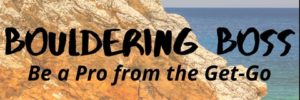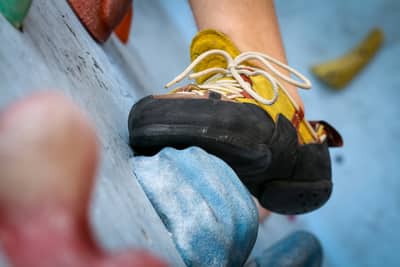Are you brand new to bouldering? Here is a super-quick start guide covering the basics. For more in-depth articles, see the links at the bottom of this page.
First, Find a Bouldering Gym
Indoor bouldering can be done in a bouldering gym, or in a climbing gym that has a bouldering wall.
Bouldering gyms are well padded, and you won’t need a partner or spotter.
Climbing gyms may require you to pass a top rope belay test, even if you only plan on bouldering. The cost for the test is about $10.00.
Check with the gym at least a week ahead in case reservations are needed. Gyms may offer a day pass, or may require booking ahead for a 2-3 hour session.
If your children will be bouldering, check ahead for age-appropriate walls. Be aware that you will be expected to supervise them yourself. For young children, there will be an arms-length requirement that you remain close to your child.
Basic Bouldering Equipment Needed
For the first few sessions, plan on renting bouldering shoes at the gym. This will give you enough experience to have an idea of what to look for when buying. For example, after renting shoes for 4-5 sessions, I knew that a very snug fit in the toe box was crucial for performance, and that laces would be better for my narrow feet than the rental’s Velcro straps.
Socks are worn with rented shoes, and not worn when wearing your own.
Wear abrasion-resistant clothes that allow a lot of freedom of movement, and make sure that your pants are tapered enough to allow you to easily see your feet.
Liquid chalk is great for keeping dust out of the air and out of the lungs. Since 2020, gyms tend to favour the use of alcohol-based liquid chalk over powdered chalk because the alcohol content sanitizes hands and holds. There may be some available for purchase at the gym.
A boar’s hair brush is handy for cleaning holds.
At the Start of Your First Bouldering Session
Let the sign-in staff know that you are new to the sport. They will provide a quick orientation to the gym’s basic safety rules, and will show you where to find the beginner V-grade problems.
Take off all jewelry and your watch before climbing, as these can get snagged on holds.
Keep all items away from the landing areas, including iphones and water bottles. Bouldering gyms will usually have a wall of cubby holes or lockers where you can stow your street shoes and personal items.
Start the session with a warmup that will get the blood flowing and raise body temperature. Skipping rope, running on a treadmill, or jogging in place, are good ways to do this. Warm up the shoulder joints, arms, and wrists to lower the risk of injury.
Start off on a problem graded VB (B means for beginners) or V0, these are the least difficult and have large easy holds.
Tips to Keep In Mind While on the Wall
Before starting the climb, stand back and study the problem. Have a clear idea of the path you will take on the way up, and give some thought to how you will get back down.
On the wall, use your legs to hold most of your weight, while using the arms mainly for positioning. Use the larger, stronger leg muscles to push up, rather than pulling yourself up by the arms.
After reaching the top of the problem, it’s a great idea to climb back down instead of jumping. Jumping down is tempting, but there are a lot of benefits to downclimbing: it extends wall and practice time, it gets your body used to moving in directions other than “up”, it reduces wear and tear on the joints, and it decreases the risk of injury because even an intentional fall carries risk.
Don’t use a death grip on the handholds, this brings on early fatigue. Use just enough grip to hang on securely.
Climbing with bent arms is exhausting. When taking a pause to figure out a next move, make a point of straightening the arms and resting your weight on your feet.
When to End the Bouldering Session
End the session before the skin on your hands becomes pink and tender. If you push through the pain, it may take a full week before the skin can handle another session.
To prevent a tendon overuse injury, end the session before your muscles are aching. Tendons take much longer than muscles to adjust to the demands of bouldering.
Stretch after the Session
Stretching for range of motion is very important, but it is more effective to do this after a bouldering session than before. After a bouldering session, your muscles will be warmed and nicely primed for a good stretch.
Stretching before bouldering reduces performance because the muscles are temporarily weaker. It also increases the risk of injury because the joints are less stable after stretching.
Is Strength Training Recommended?
Strength training is not recommended for the first year of bouldering. The best training for bouldering is bouldering, which develops the strength and skills that directly apply to the sport. In the beginning, it is more important to focus on proper form than on strength.
For more information, check out the following articles:
- Bouldering Rules: using the Starting and Finishing Holds
- Can an Overweight Person Do Bouldering?
- How to Progress as a Beginner in Bouldering
- Bouldering Etiquette: Basic Tips to Stay Popular in the Gym

